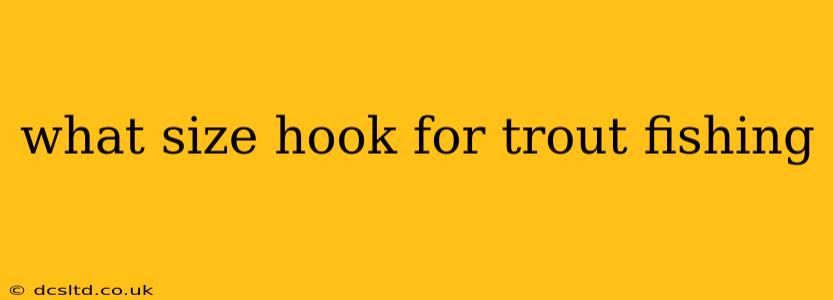What Size Hook for Trout Fishing? Choosing the Right Hook for Success
Selecting the right hook size for trout fishing is crucial for maximizing your catch rate. The ideal hook size depends on several factors, and choosing incorrectly can mean the difference between a successful day on the water and a frustrating one. This guide will help you navigate the complexities of hook selection and ensure you're using the right size for the type of trout you're targeting and the fishing technique you employ.
What factors determine hook size for trout?
The size of the hook you choose is not arbitrary. Several key factors influence this decision:
-
Size of the Trout: This is the most important consideration. For smaller trout (under 10 inches), you'll want smaller hooks, typically in the #10 to #16 range. Larger trout (over 12 inches) will require larger hooks, ranging from #6 to #8 or even larger, depending on the bait or lure used.
-
Type of Bait or Lure: The size of your bait or lure dictates the appropriate hook size. A small fly will need a tiny hook, whereas a larger spoon or spinner will require a sturdier, larger hook. Make sure the hook is proportional to the bait or lure – you want the hook to be hidden or subtly integrated, not overpowering the offering.
-
Fishing Technique: Different fishing techniques call for different hook types and sizes. For example, dry fly fishing often employs smaller, lighter hooks, while wet fly fishing or spinning may use larger, stronger hooks.
-
Water Conditions: Clear water often necessitates smaller, finer hooks to avoid spooking wary trout. Murkier water might allow for slightly larger hooks.
What are the most common hook sizes for trout?
While the ideal hook size depends on the specifics mentioned above, here's a general guideline:
-
#10 - #16: These smaller hooks are ideal for smaller trout and delicate presentations, such as dry fly fishing with small flies or nymph fishing.
-
#6 - #8: These medium-sized hooks are suitable for medium-sized trout and a variety of bait and lure presentations.
-
#2 - #6: These larger hooks are suitable for larger trout and larger lures or bait.
What are some popular hook styles for trout?
Beyond size, the style of the hook is crucial. Several popular styles are commonly used for trout fishing:
-
Dry Fly Hooks: These hooks are typically lighter and designed for dry flies, which float on the surface of the water.
-
Nymph Hooks: These hooks are slightly heavier and designed for nymphs, which are submerged insects.
-
Wet Fly Hooks: These hooks are heavier and designed for wet flies, which are fished below the surface.
-
Spinner Hooks: These hooks are typically stronger and designed for spinners and other lures.
-
Bait Hooks: These hooks come in various sizes and styles, designed to hold a variety of bait such as worms, insects, or salmon eggs.
What hook size should I use for different bait types?
-
Worms: Match the hook size to the worm's size; use a slightly smaller hook to allow the worm to move freely.
-
Salmon Eggs: Smaller hooks are typically preferred, allowing the eggs to present naturally.
-
Insects (live or artificial): Match the hook size to the insect's size.
-
Lures (spoons, spinners, etc.): The hook size is generally determined by the lure size and manufacturer's recommendations.
Are there any other considerations when choosing a hook size?
Yes! Consider the hook's strength and material. Stronger hooks (made of materials like steel or titanium) are needed for larger fish or aggressive fishing techniques. The hook's point sharpness is also crucial for successful hooking.
By carefully considering these factors, you'll be well-equipped to select the appropriate hook size for your next trout fishing adventure, significantly increasing your chances of landing that trophy trout. Remember, practice and experience will help you refine your hook size selection based on your specific conditions and preferred fishing techniques.
